
.png)
If you're reading this post, you've found it: the only Google Calendar hacks guide you'll ever need. By the time you're done reading it, your calendar will be changed forever. In a good way.
This post contains some of the same stuff you might have seen before, but with a twist: we're giving you tools and techniques that will completely change how you use your calendar to manage your workweek. In other words, we're not just going to list off every cool hidden feature we know about in Google. Instead, we're going to show you how to make your calendar your best friend.
Most of these tips can be done with just Google Calendar, but many of them become even more powerful when paired with Reclaim. We heartily recommend that you get Reclaim set up before (or immediately after) reading this guide.
The first thing to do if you're planning on making some big changes to your calendar is understand where your time is currently going. Too often, we make micro-adjustments to our schedules -- cancelling a meeting here or there -- without looking at the broader picture.
When it comes to auditing your calendar, there are lots of ways to slice it, but a simple way to start is by evaluating three key categories of time:
- Meetings: how much of my week am I spending in meetings with other people?
- Free Time: how much of my week is free and defended for focused work?
- Personal: how much of my week is dedicated to my own life?
You can dive deeper once you've established these baselines, but this is the right place to start. In general, we think of Meetings and Free Time in Pareto terms: no more than 80% of your workweek should be comprised of meetings, and no less than 20% of your workweek should be free for focused work.
If you use Reclaim, you can actually get this data from your calendar automatically. No spreadsheets, no mental math, no nada. When you finish setting things up, we'll give you a report that updates in real time:
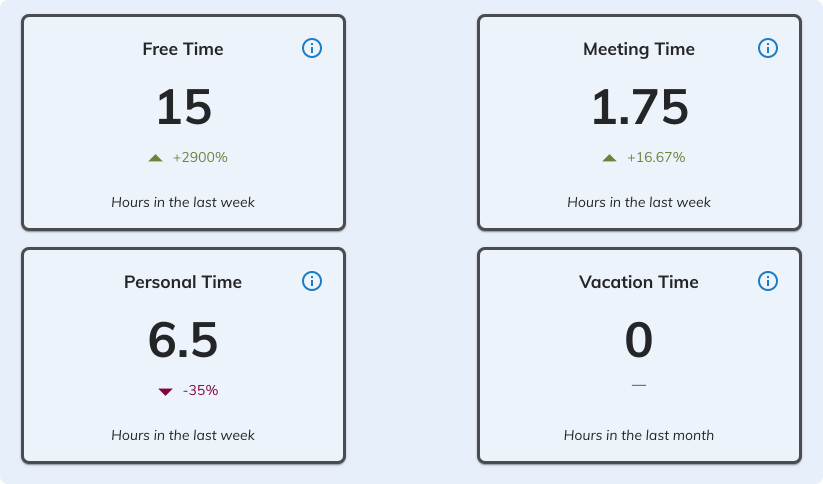
OK, so now you know where your time is going. The next thing to do is make your calendar a visual map of where your time goes. Luckily, Google has a nice way to do this directly from your calendar: color-coding.
At Reclaim, we have a strong opinion that you should be color-coding your calendar based on your priorities. That way, it's easy for you to understand where your time is going at a glance. More broadly, your calendar should have color codes for a few key categories:
- Priorities: pick the 3-5 most important things you want to spend time on each week and start "tagging" events that map to those priorities with their own colors
- Personal: give your personal events a distinct color so they stand out from the rest of your events. This will make it easy for you to know when you've got a life event that you need to make time for. Do the same thing for lunch time.
- Travel: same as above -- give your travel time its own color so you know when you have to travel somewhere and don't let your meetings run over
- Focus: give your focused time its own color. Again, same idea here: you want the "breaks" in your day to stand out.
When you're all done, your workday might look something like this:
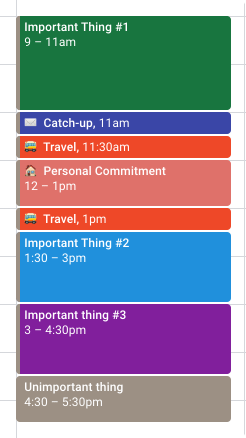
It's super easy to color-code your events. All you need to do is right-click on an event in Google Calendar, pick your color, and you're done:

Just like auditing your calendar, Reclaim automates a lot of this for you! We'll automatically block and color-code your personal, travel, and focus time so you don't have to worry about maintaining it. Which brings us to...
Simple stuff, right? Make sure you've blocked time on your calendar for the following things:
- Focus: catching up on email, tasks, and other stuff 1-2x a day to keep you from being snowed under
- Lunch: eating lunch for at least 25m a day to keep your brain working
- Personal: spending time by yourself or with your family to take a walk (safely) or take a break from work
The problem is that time blocking is a static activity, and our calendars are dynamic creatures. Meetings come in, trampling over our perfectly-crafted calendar.
This is where Reclaim can really help you. Instead of just blocking time, Reclaim automatically moves your focus and lunch time around as interruptions occur, marking those events as "busy" and defending them from others once it's clear your day is too full. Best of all, you don't have to worry about blocking time yourself: we do all the work for you.
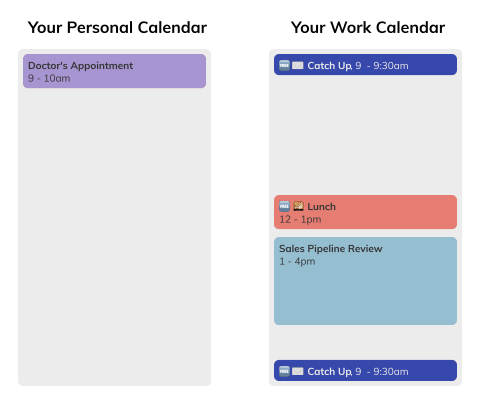
Your personal stuff lives on your personal calendar, and your work stuff lives on your work calendar. The problem? Your coworkers can't see the stuff that's on your personal calendar. You end up overbooked, apologizing, and missing out on important life events.
There isn't a native solution for this in Google, so we built our own. Reclaim keeps events from your personal calendar(s) automatically blocked on your work calendar, and keeps them up to date as changes occur. You can see all your events in one place, and your coworkers won't ever book over your personal life.
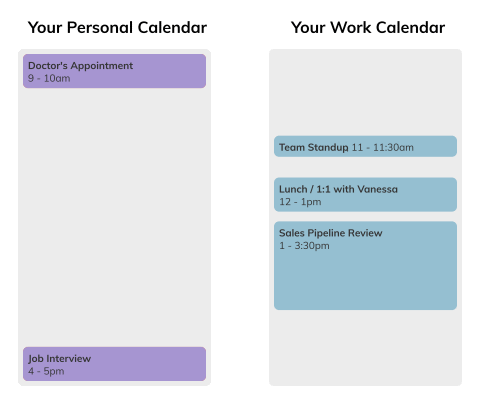
How many calendar tabs do you have open in your browser right now? Answer: too many.
Chances are, you spend the majority of your "calendaring time" in just one calendar: your work calendar. So, why not make sure you only need to go to one calendar to see all your events in once place? The key to this is to share your calendars with your work calendar.
Here's how to do it (or, if you're feeling lazy, you can just sign up for Reclaim -- we share your calendar automatically with two clicks):
- Go to the calendar you want to share with your work calendar in Google Calendar
- Click the Settings gear icon in the top right of the UI

- Under Settings for my calendars, select the calendar you want to share and then click Share with specific people
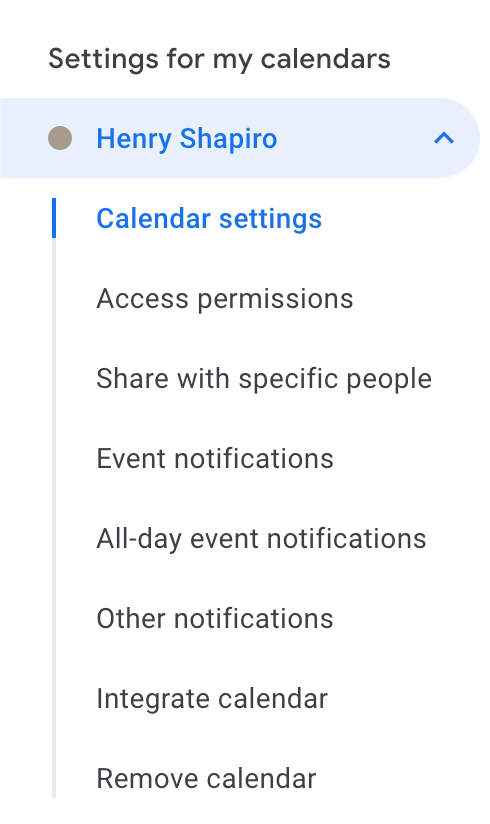
- Click Add people.
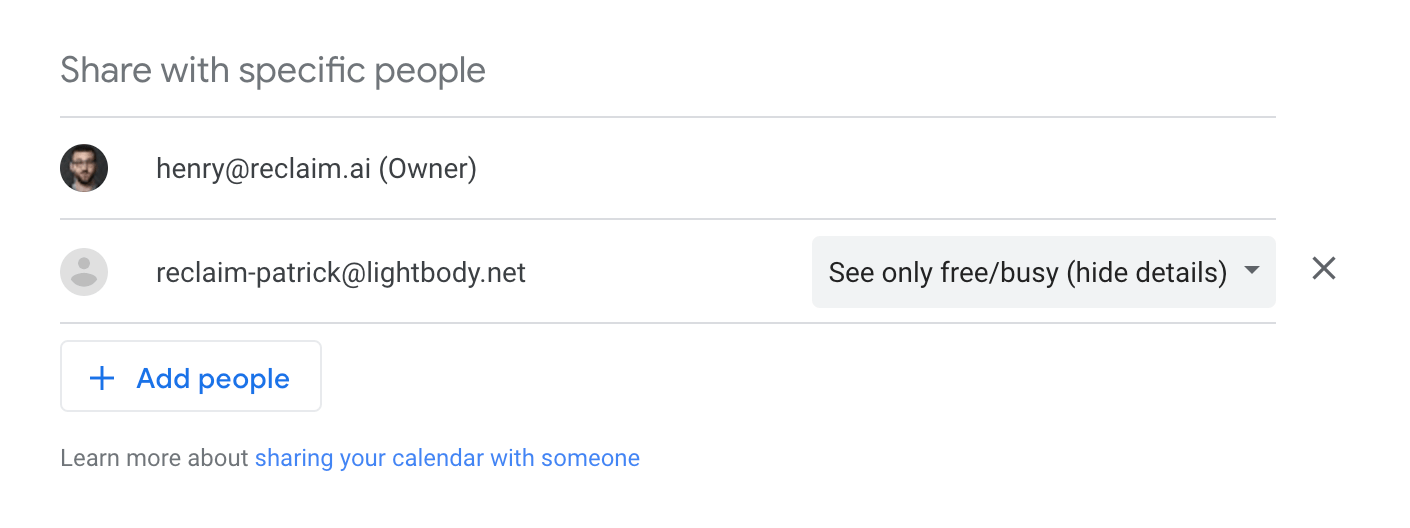
- Enter in the work email address associated with the work calendar you want to share this calendar with. Under Permissions, select "Make changes to events". This will enable you to actually manage all your events from your work calendar without having to switch tabs! (Note: your IT administrator may have locked this permission down. If it's not available, simply select "See all event details".
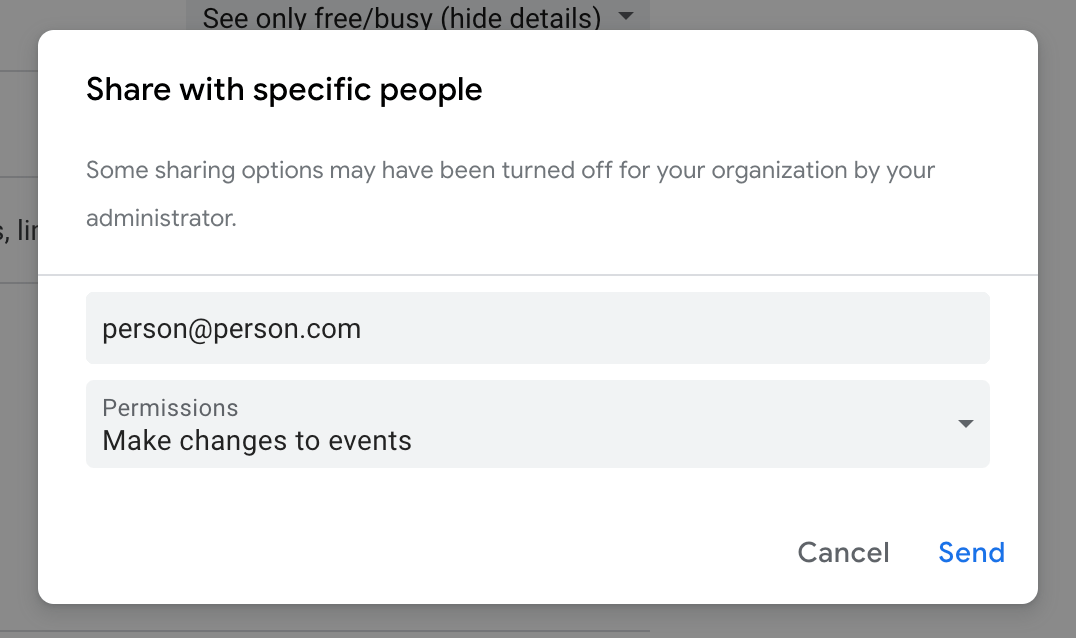
- Click Send. Note that you'll have to accept the invite from your work email before the sharing will become active.
Now, you'll be able to see your calendars in one place! If your calendar looks cluttered, remember that you can always toggle calendars on and off without losing your sharing settings:
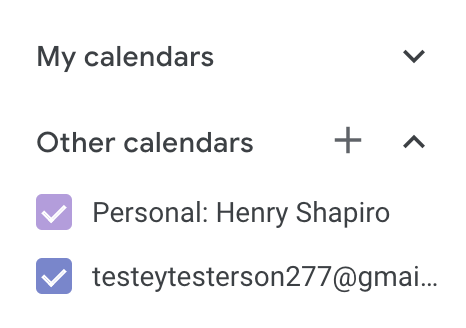
These instructions assume you are sharing a Google calendar with another Google calendar. If you're using iCloud or Outlook for your personal calendars, here are some great guides for sharing those calendars:
You probably know that Google will automatically create calendar events from your email. It's a really nice way to make sure that when you're invited to something (but don't create it on your calendar) it still shows up.
Keeping your time defended is all about coverage: the more coverage for your life you have on your schedule, the harder it is to interrupt. Let's make sure you're getting as much coverage as possible.
Turning on Events from Gmail is easy:
- Go to Settings in Google Calendar's UI
- Under General, select Events from Gmail
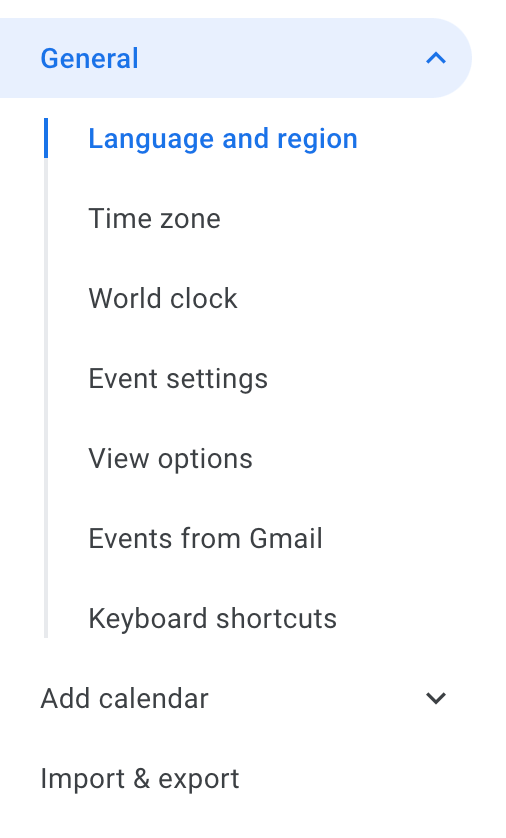
- Check the box next to "Automatically add events from Gmail to my calendar". Under "Visibility of Gmail events", select "Private". This will ensure that events show up on your calendar, but details of them won't be visible to anyone else.

Make sure this is turned on for all your calendars, including the ones that you've shared with your work calendar.
This is a controversial topic, so we'll keep it simple: yes, you should probably keep your calendar private for the most part. Your peers don't need to know every single thing that you do. But certain people -- especially people who work with you a lot -- probably would benefit from knowing if you can be interrupted or not.
Same goes for particular kinds of events: if someone looks at your calendar and just sees Busy plastered across the screen, they have no idea if you're working on something that can be interrupted or not.
So, our opinion here is straightforward: make your calendar private, share it with others selectively, and then make certain kinds of events public so that others know when you're heads-down. If you use Reclaim, we automatically make lunches, catch-up time, and travel time public so that other people know when you're busy eating or trying to focus.
Here's how to do that:
- Go to Settings for your work calendar
- Go to Settings for my calendars, click on your primary work calendar, and then click Access permissions
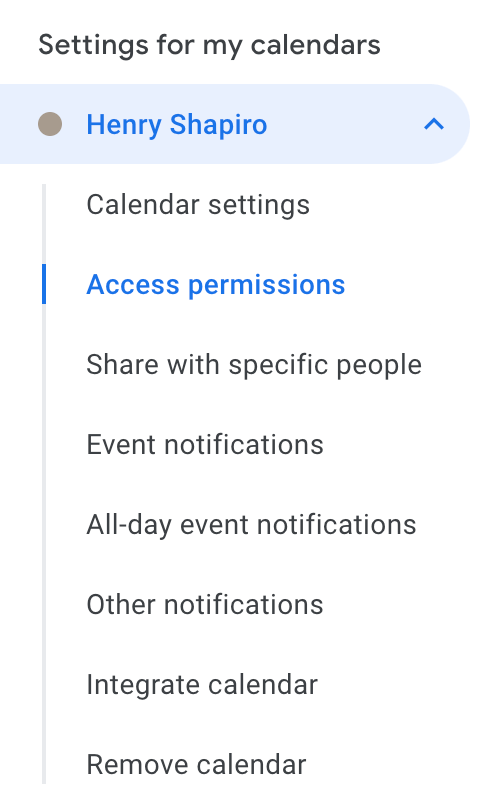
- Check Make available for [Your Organization] and then select See only free/busy (hide details). This will make your calendar's details hidden by default.

- Below, under Share with specific people, you can add specific people that you'd like to have special visibility permissions -- for example, your team that might want to know what you're up to or people you meet with frequently.
- When you create events, you can now opt to make them Public, or just use the default permission we just set. For example, if you're heads down writing something and you don't want to be disturbed, this is a powerful way to send that signal to others.
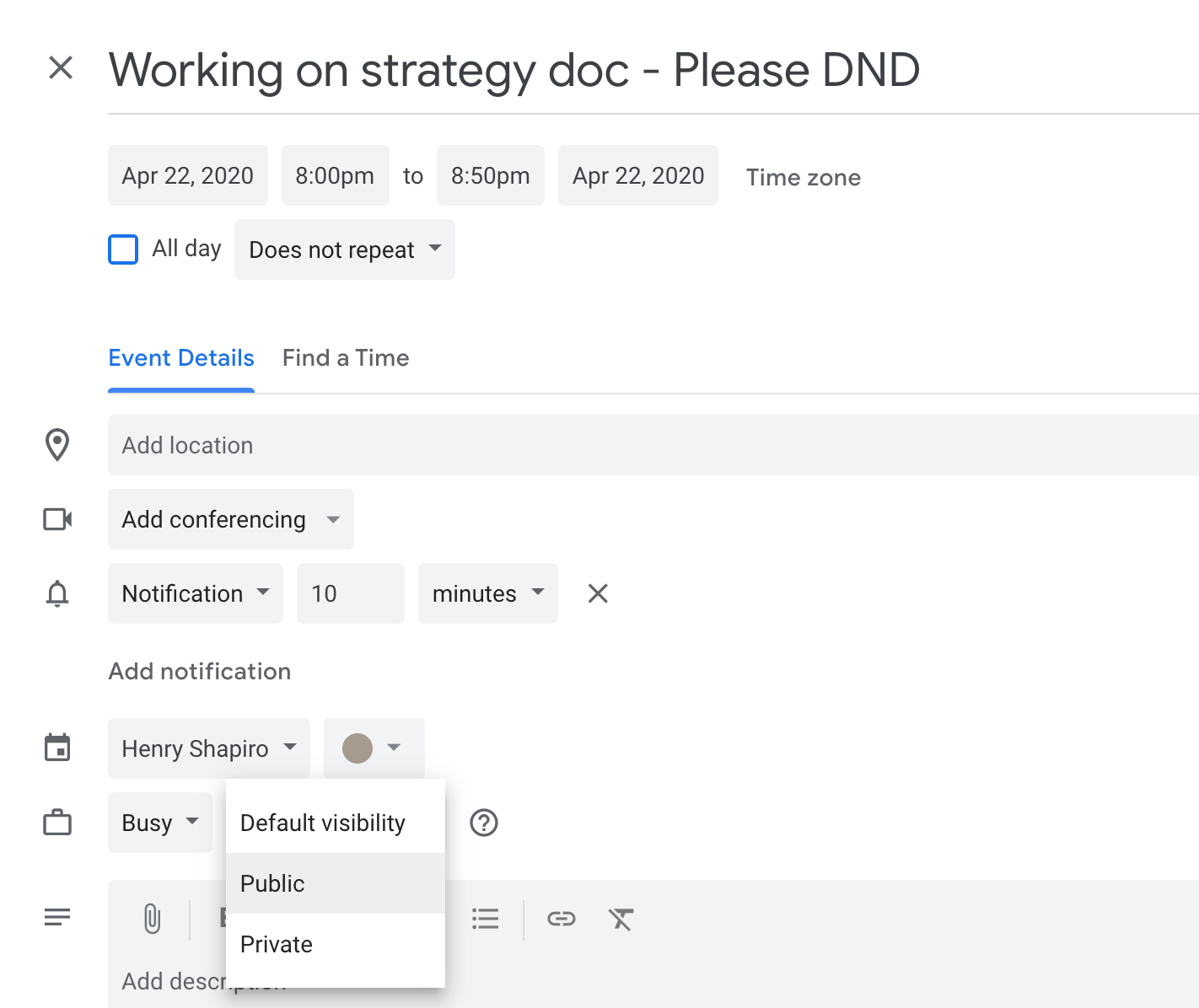
Recurring meetings are like debt that never gets paid down: they persist from week to week and consistently take up your time. A habit we've developed over the years is to look 1-2 weeks ahead on the calendar and see what meetings are there. You'll probably find a lot of recurring 1:1s, group meetings, status reporting meetings, and so on that may or may not be serving their useful purpose.
This isn't to say that you should just decline all these meetings, but instead use our handy guide on How To Decline Meetings Without Looking Like a Jerk to pick and choose the ones that you think will serve you and your team's goals. Recurring meetings might be eating up a lot of time that could be better spent, and they're typically one of the first things we look for when trying to improve someone's calendar.
Google Calendar can be painful to work with, particularly when you're doing some deep calendar surgery. Keyboard shortcuts are a powerful way to make it easier. There are a ton of keyboard shortcuts available in Google Calendar, but we're going to focus on the ones that we think are most impactful.
First off, though, let's make sure you have keyboard shortcuts turned on:
- Go to Settings from your calendar
- Under General, select Keyboard shortcuts
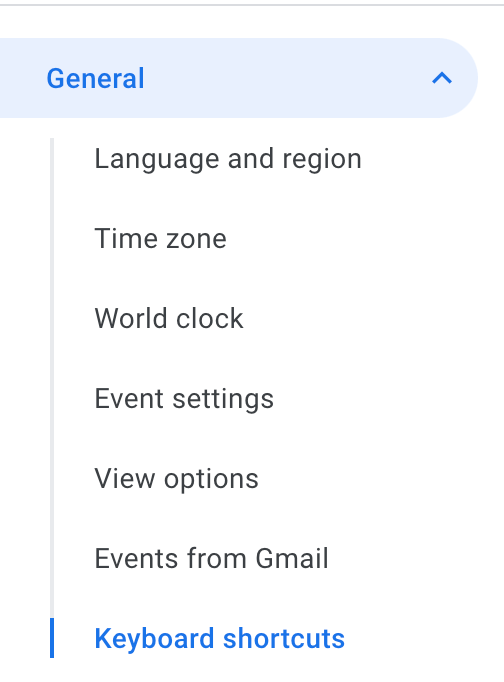
- Check the box next to Enable keyboard shortcuts

Now, go back to the calendar view and press Shift-? on your keyboard. This will bring up a big list of keyboard shortcuts.
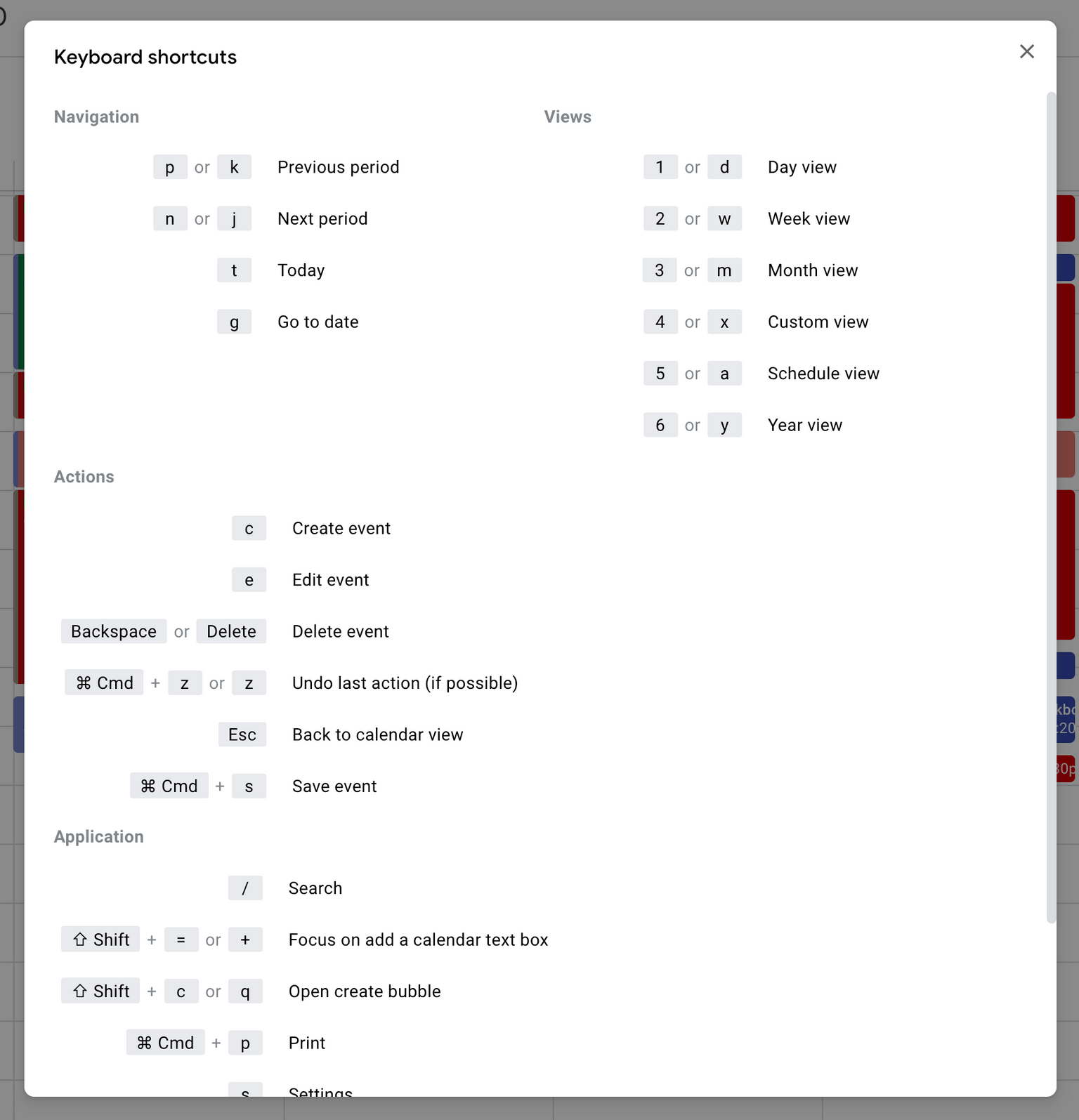
Woof. That's a lot of shortcuts. Here are the ones that matter most:
Don't worry. You'll be a keyboard wizard in no time.
An easy way to keep people from booking you at odd hours of the day is to set your working hours in Google Calendar. When people book a meeting outside your working hours, they'll get a notification telling them that:

To set your working hours:
- Go to Settings from your work calendar
- Under General, select Working Hours

- Set your Working Hours!
This is a great way to set boundaries as you move to working from home. It's not perfect, but it helps to create parameters around your schedule.
If you work with remote teams -- maybe a team that's several hours ahead or behind your timezone -- a secondary timezone is a great way to see if you might be booking a meeting that is unfriendly to the time change.
You can turn on a secondary timezone by following these steps:
- Go to Settings for your work calendar
- Under General, select Time zone

- Check Display secondary time zone, then select the other time zone you want to display on your calendar. You can even add labels to your timezones so they show up in a non-GMT way.

Now, when you book events, you'll see two timezones that let you know what time you're scheduling a meeting for in another team's timezone.
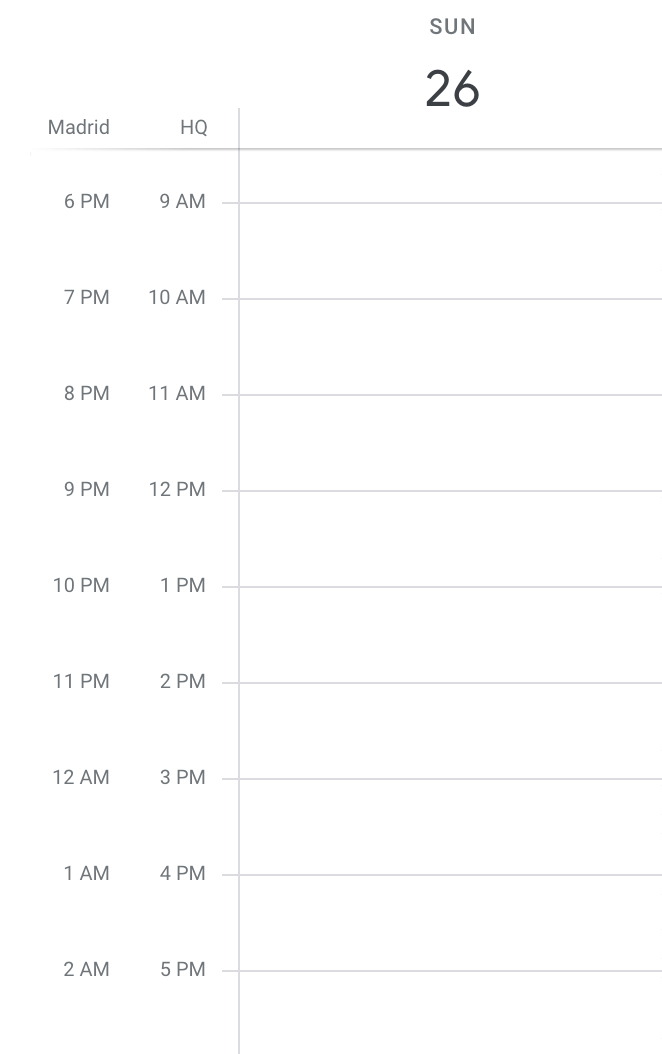
How often do you get asked to move an event by someone else?
By making your events modifiable by others by default, you open up your schedule to other people and democratize the process of finding times. That way, when someone tells you that they need to move your meeting, you can ask them to take the reins.
Turning on this setting is simple:
- Go to Settings for your work calendar
- Under General, click Event Settings
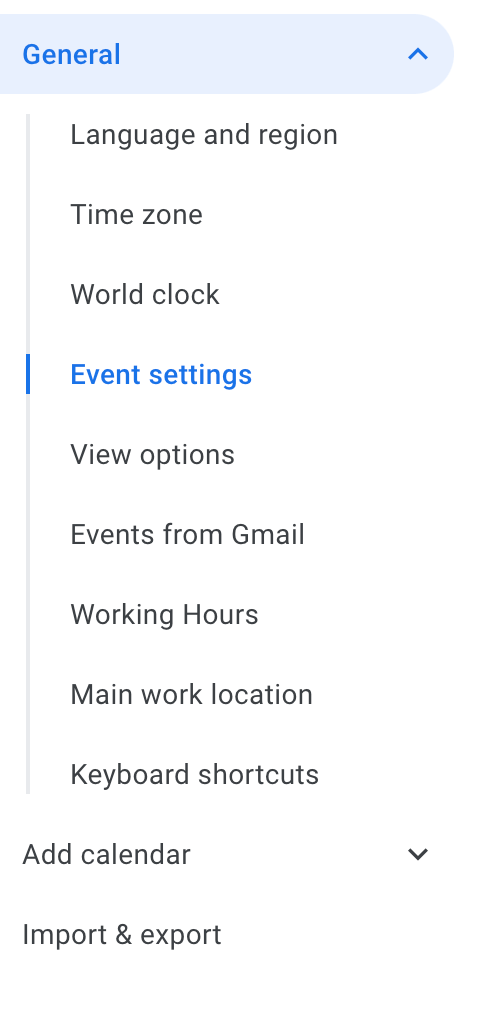
- Under Default guest permissions, select Modify event
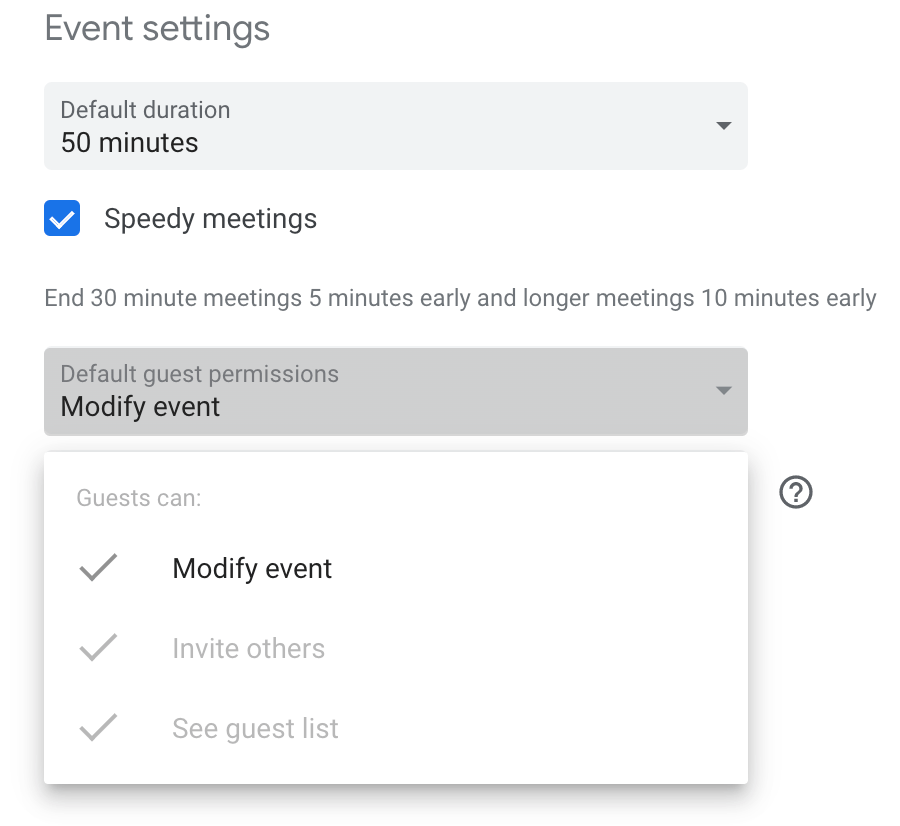
Note that now, by default, every event you create will have this permission on. If you ever decide you don't want someone modifying your meeting, you can change this setting for any given event:
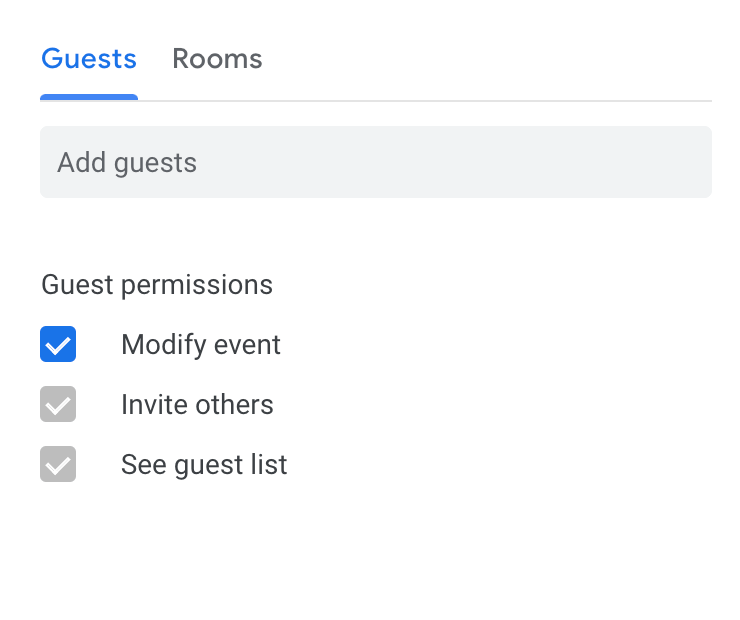
You don’t need to make your eyeballs suffer any more than they have to. This is a simple way to visually distinguish the past from the present on your calendar.
Here's how to turn this on:
- Go to Settings for your work calendar
- Under General, select View Options
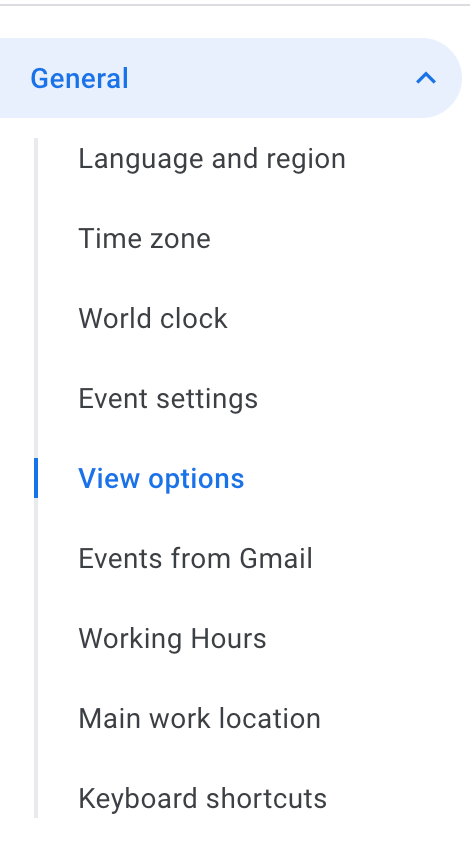
- Check the box next to Reduce the brightness of past events

Here's what it ends up looking like on your calendar:
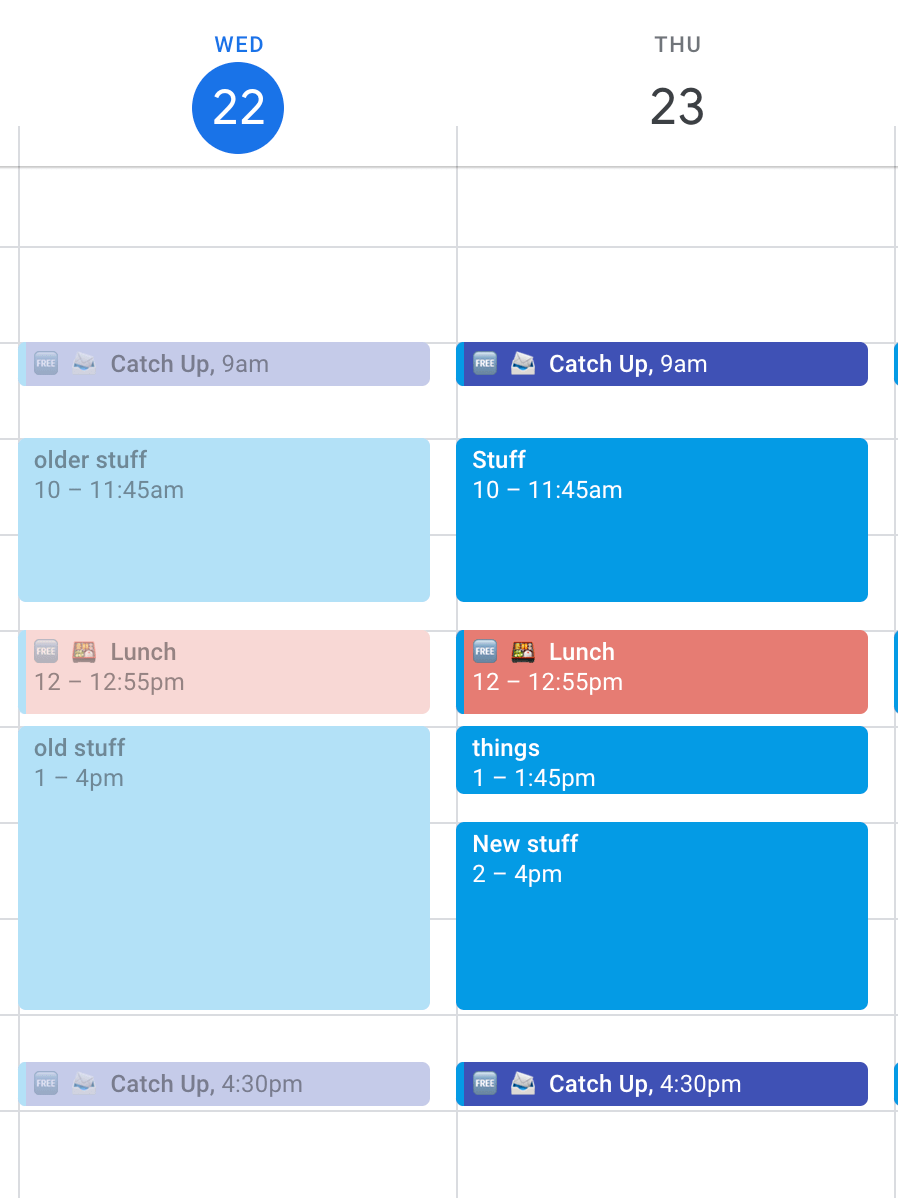
This is a great way to de-clutter your brain when looking at your calendar -- focus on the future, not the past.
Sometimes it’s good to see an agenda instead of the traditional calendar view. It gives you a sense of your day’s events at a glance without having to decipher a bunch of colorful blocks. Best of all, all your fancy color coding (see tip #2) persists in this view.
To do this, you can either use your newfound keyboard shortcut skills and press a on the keyboard, or you can select it from the dropdown in the top right of Google Calendar's UI:
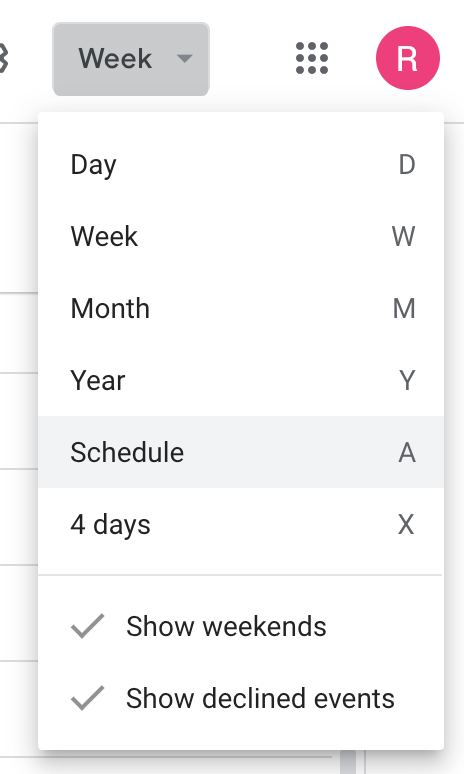
As much as we dread email, sometimes it’s useful to get a report of what your day is going to look like when you wake up so that you know what’s coming and are properly prepped and caffeinated for the challenge ahead.
To get a daily digest:
- Go to Settings on your work calendar
- Under Settings for my calendars, select your primary work calendar and click Other notifications
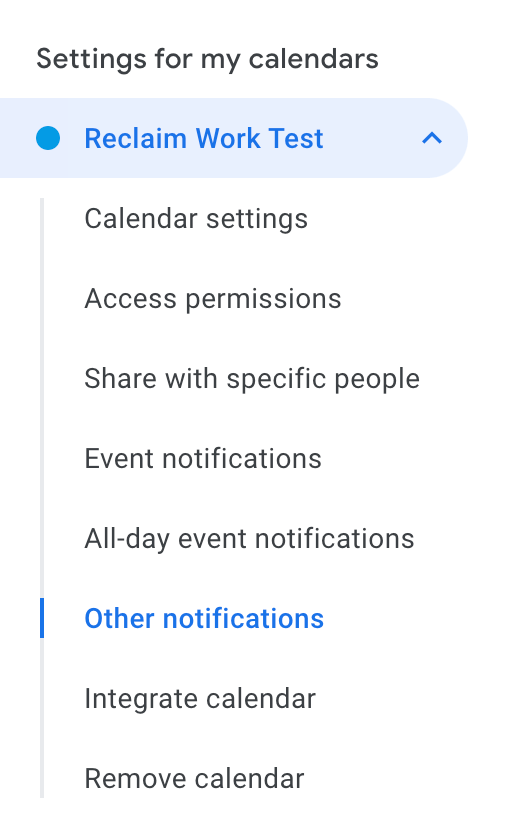
- Now, select Email under "Daily Agenda"
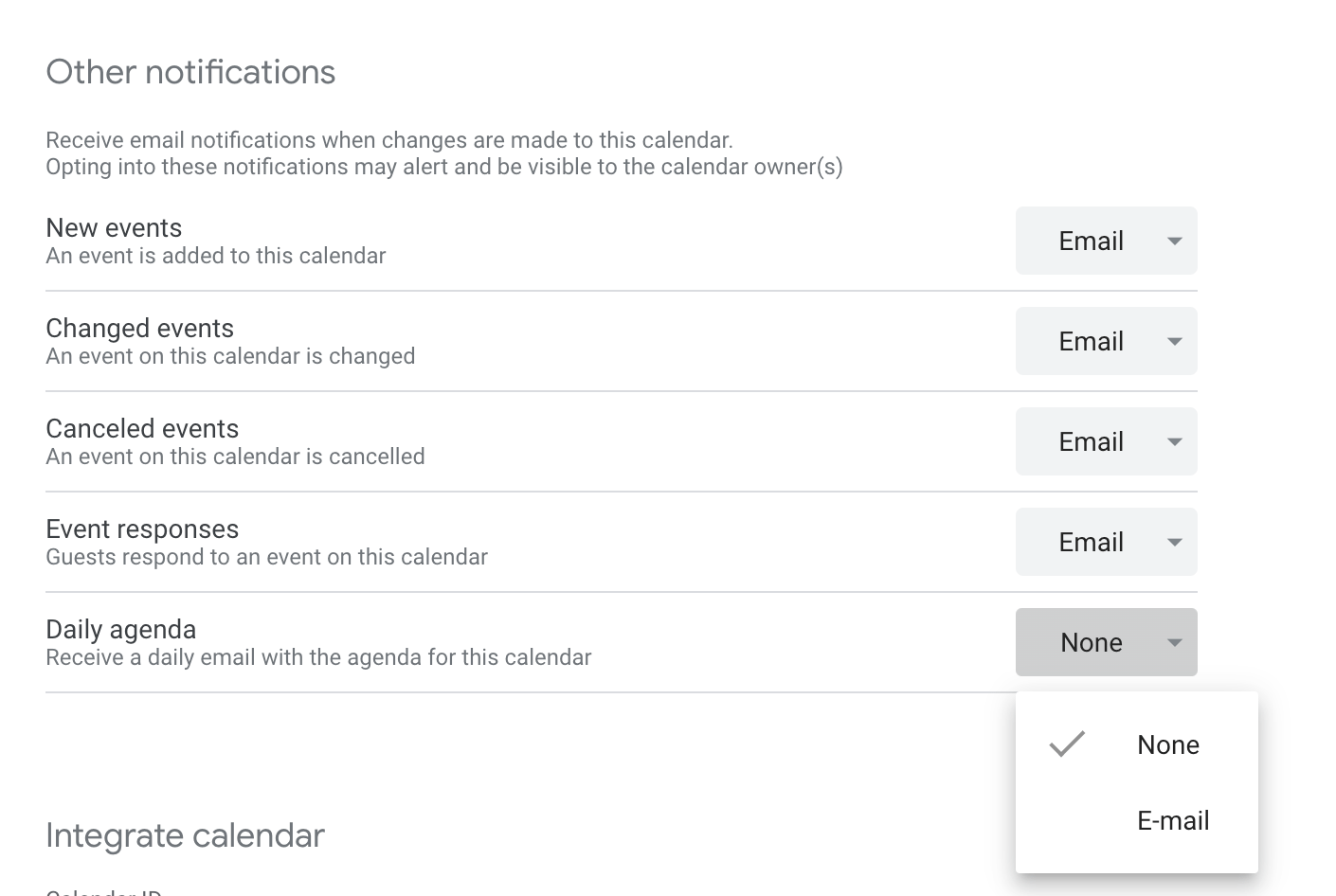
Now, you'll get an email at 5am in your timezone each day summarizing your day's events!
Speedy Meetings is an awesome way to accomplish two goals at once:
- It guarantees that you have a bit of time in between meetings to take a break.
- It keeps you from falling into the trap of having hour-long meetings that should really only be 45 minutes.
When you turn this feature on in Google Calendar’s Settings page, it’ll make it so that your new calendar invites default to either 25 or 50-minute chunks, which will give you back a bit of time (and maybe even encourage the meeting to end a bit sooner).
Here's how to turn it on:
- Go to Settings on your work calendar
- Under General, select Event Settings
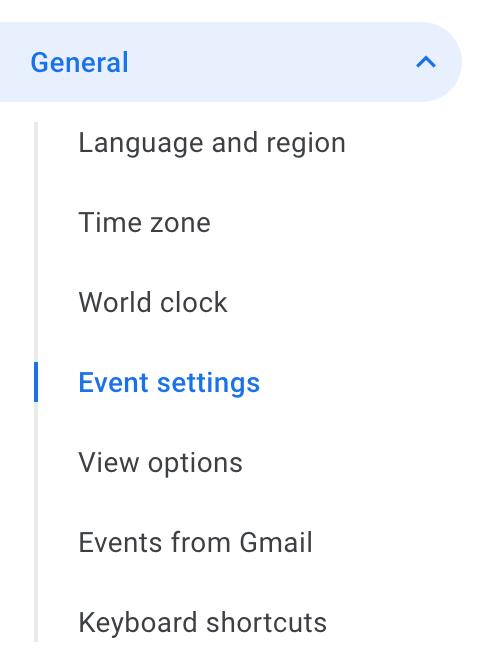
- Check the box next to Speedy Meetings
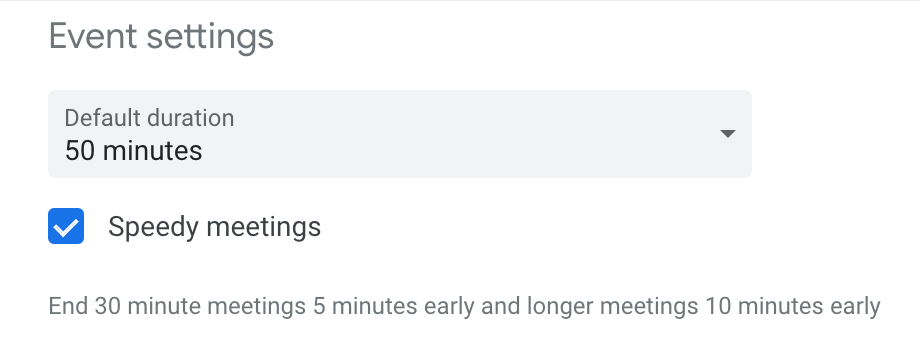
Now, you'll see that your meetings will default to more expeditious durations!
Whew! That was a lot of calendaring. If your calendar is still feeling out of control, never fear: Reclaim is here to make it a bit easier. If you don't want to spend time blocking your calendar out and instead want to spend it doing...literally anything else, sign up now.
Got questions, or have any tips that we missed? Drop us a line on Twitter or send us an email.
Productivity Trends Reports
Ready for an
AI calendar?
Auto-schedule focus time, meetings, & breaks on Google Calendar + Outlook Calendar.
Start scheduling →It's free! 🎉






























